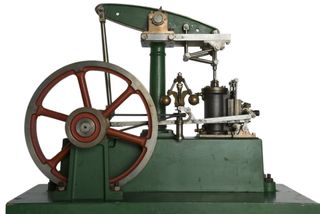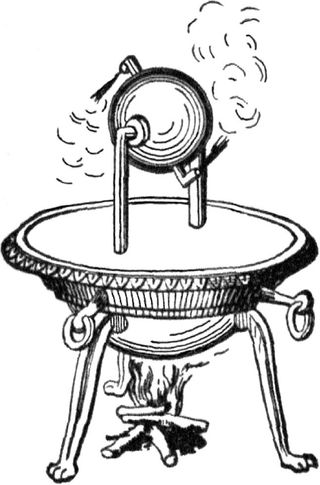Who Invented the Steam Engine?

In a world propelled by combustion engines, gas turbines and nuclear reactors, the steam engine may seem like a relic of the past. But without this game-changing invention, the modern world would be a much different place.
Arguably the most important development of the Industrial Revolution, the steam engine facilitated major advancements in the fields of mining, manufacturing, agriculture and transportation. And while several prominent figures of the 18th and 19th centuries are credited with developing and improving the steam engine, the history of steam-powered machines actually goes back nearly 2,000 years before the Industrial Revolution.
Ancient steam turbines
Early in the first century A.D., a Greek inventor named Hero of Alexandria designed the world's first aeolipile, or primitive steam turbine. Heron's aeolipile consisted of a hollow sphere, mounted on a pair of tubes. Heated from below by fire, the tubes transported steam to the sphere, where it was released through another series of tubes projecting from the sphere's equator. This movement of steam through the device caused the sphere to revolve, demonstrating the potential for using steam as a means of propulsion.
While Hero's aeolipile was created as a novelty, not a means of speeding up production, it is nevertheless the first known device to transform steam into rotary motion. But it wasn't until the 17th century that attempts were made to harness the power exhibited by Heron's aeolipile for practical purposes.

Steam: A perfect solution
The first practical steam engines were developed to solve a very specific problem: how to remove water from flooded mines. As Europeans of the 17th century switched from wood to coal as their main source of fuel, mines were deepened and, as a result, often became flooded after penetrating underground water sources.
A Spanish mining administrator named Jerónimo de Ayanz is thought to have been the first person to solve the problem of flooded mines. In 1606, de Ayanz registered the first patent for a machine that used steam power to propel water from mines. The Spanish inventor — who is also credited with inventing one of the world's first air conditioning systems — used his steam engine to remove water from silver mines in Guadalcanal, Seville.
While the Spaniard first patented a steam-operated machine for use in mining, an Englishman is usually credited with inventing the first steam engine. In 1698, Thomas Savery, an engineer and inventor, patented a machine that could effectively draw water from flooded mines using steam pressure. Savery used principles set forth by Denis Papin, a French-born British physicist who invented the pressure cooker. Papin's ideas surrounding a cylinder and piston steam engine had not previously been used to build a working engine, but by 1705, Savery had turned Papin's ideas into a useful invention.
Using two steam boilers, Savery devised a nearly continuous system for pumping water from mines. But despite the early success of Savery's system, it was soon discovered that his engine was only capable of drawing water from shallow depths, a problem that needed to be overcome if steam engines were to function in deep mines.
Luckily for European mine owners, in 1711 another Englishman, Thomas Newcomen, developed a better way to pump water from mines. His system used a redesigned steam engine that eliminated the need for accumulated steam pressure — a flaw in Savery's system that led to many an unfortunate explosion. Newcomen's "atmospheric" engine — so named because the level of steam pressure it used neared atmospheric pressure — was the first commercially successful machine that used steam to operate a water pump.
Despite it's being an improvement on Savery's initial rendering of the steam engine, Newcomen's atmospheric engine also had its flaws. The machine was highly inefficient, requiring a constant flow of cold water to cool the all-important steam cylinder (the part of the engine where steam pressure is converted into motion), as well as a constant energy source to reheat the cylinder.
Regardless of this major drawback, Newcomen's engine design went unchallenged for the next 50-or-so years and, aside from pumping out mines, was also used to drain wetlands, supply water to towns and even power factories and mills by pumping water from below a water wheel to above it for re-use.

Powering the Industrial Revolution
But by 1765, the fate of Newcomen's engine was sealed. In that year, James Watt, a Scottish instrument maker employed by Glasgow University, began repairing a small model of a Newcomen engine. Watt was perplexed by the large amount of steam consumed by Newcomen's machine and realized that to remedy this inefficiency, he would have to do away with the constant cooling and reheating of the steam cylinder.
To do this, Watt developed a separate condenser, which allowed the steam cylinder to be maintained at a constant temperature and dramatically improved the functionality of Newcomen's engine.
For financial reasons, Watt wasn't immediately able to manufacture his new and improved atmospheric engine. But by 1776, he had formed a partnership with Matthew Boulton, an English manufacturer and engineer dead-set on using steam engines for more than just pumping water from mines.
With financial backing from Boulton, Watt developed a single-acting (and later, a double-acting) rotative steam engine that, along with Watt's signature separate condenser, featured a parallel motion mechanism that doubled the power of the existing steam cylinder. The Boulton-Watt engine was also the first that allowed the machine's operator to control the engine speed with a device called a centrifugal governor. The improved engine used a new gear system — developed by Boulton and Watts' employee, William Murdoch — known as sun and planet gearing, to convert reciprocating (linear) motion into rotative motion.
Watt's improvements to the steam engine, combined with Boulton's vision of a nation powered by steam, facilitated the rapid adoption of steam engines across the United Kingdom and, eventually, the United States. By the 1800s, steam engines were powering mills, factories, breweries and a host of other manufacturing operations. In 1852, the first flight of a steam-powered airship took place. Future iterations of the steam engine also came to define travel, as trains, boats and railways adopted the technology to propel passengers into the 20th century. [See also: How the Steam Engine Changed the World]
Follow Elizabeth Palermo on Twitter @techEpalermo, Facebook or Google+. Follow LiveScience @livescience. We're also on Facebook & Google+.
Sign up for the Live Science daily newsletter now
Get the world’s most fascinating discoveries delivered straight to your inbox.

Elizabeth is a former Live Science associate editor and current director of audience development at the Chamber of Commerce. She graduated with a bachelor of arts degree from George Washington University. Elizabeth has traveled throughout the Americas, studying political systems and indigenous cultures and teaching English to students of all ages.
